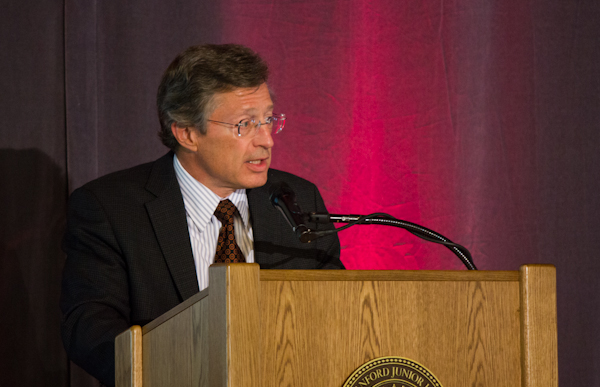
Stanford administrators announced a new sustainability plan at Monday evening event focused mostly on the University’s past successes in sustainability. Titled “Sustainability 3.0,” the plan will guide Stanford’s sustainability efforts over the next five to 10 years.
The full “Sustainability 3.0” plan has not yet been released, but Pamela Matson, dean of the School of Earth Sciences, outlined some of the principles behind the plan.
“Stanford should be the leader in sustainability in everything we do, and we need to lead by example,” Matson said, outlining the first goal of the plan.
Other goals included establishing clear sustainability policies, bringing together the entire Stanford community, reaching beyond Stanford for aid and outreach and focusing on action rather than just research.
“We need to make sure that what we learn here through our amazing research efforts is actually being used here,” Matson said.
The plan was introduced at the conclusion of an event titled “Celebrating Sustainability at Stanford,” which brought together the leaders of various sustainability efforts on campus to speak about their initiatives.
“The number one global challenge that we are going to be measured by over the next century or two is going to be sustainability,” said Tom Steyer, a Stanford trustee and the keynote speaker at the celebration.
Steyer emphasized that Stanford needs to lead in this area, especially with recent attention drawn to the University.
Referring to a recent article by Ken Auletta in The New Yorker, Steyer said, “It’s impossible to read the recent New Yorker article and not think that people around the country are going to pay attention not just to our research, but to how we actually address the problem.”
Two panels convened to share their sustainability work. The first presented sustainability research initiatives, and the second presented sustainability action initiatives.
Buzz Thompson, director of the Woods Institute for the Environment and a research panelist, noted the success of the Environmental Venture Projects program, which awards seed grants to aid faculty research projects on sustainability. Thompson said that over 350 faculty members have submitted proposals for the grants.
Lynn Orr, director of the Precourt Institute for Energy, also sat on the research panel. Orr discussed solar cell research currently in process to combine photovoltaic and solar thermal panels into double-efficiency solar cells.
The panel also noted increasing student interest in sustainability. Heather Bischel M.S. ‘07 Ph.D. ‘11, a panelist representing students, said that over the last five years, the number of courses at Stanford that mention sustainability in their course description has increased from 27 to 71.
One challenge addressed in the “Sustainability 3.0” plan was to compile these courses and make them more apparent and accessible to interested students.
On the sustainability action panel, speakers presented projects currently underway to address sustainability problems and apply research findings.
Alex Luisi ‘12, president of Students for a Sustainable Stanford (SSS), spoke about several of the group’s recent projects, including creating a smartphone application to report water leaks around campus. Luisi also discussed how rewarding students had found their sustainability efforts with SSS.
“If we gave them a chance to do it again, they’d only do more,” he said.
Luisi also introduced a short film called Sustainable Trees made by SSS members Garrett Gunther ‘11 M.S. ‘12, Dominique Yahyavi ‘11 M.S. ‘12, Kris Cheng ‘11 and Adam Selzer M.A. ‘12. The film depicts student sustainability efforts all over campus.
Brodie Hamilton, director of Parking and Transportation Services, then showed how initiatives like the Commute Club have helped reduce both traffic on campus and emissions. Hamilton said the rate of Stanford employees driving alone to work dropped to 46 percent in 2011 from 72 percent in 2002.
Carbon dioxide emissions on campus have dropped below 1990 levels, according to Hamilton. Additionally, the reduced traffic has helped Stanford avoid construction of 3,000 parking spaces.
Jack Cleary, associate vice president of Land, Buildings and Real Estate, discussed the methods used by his department to plan buildings. According to Cleary, Land, Buildings and Real Estate aims to make buildings that exceed green building code performance by at least 30 percent.
The final presenter on the research panel was Joe Stagner, executive director of Sustainability and Energy Management. Stagner discussed the upcoming Stanford Energy System Innovations (SESI) project, which has the potential to reduce emissions from water management by up to 50 percent and water use by 18 percent.
The idea behind the SESI project is that Stanford currently has separate systems to heat and cool water. Once contracts expire over the next three years, the University will begin replacing most of the water pipes and systems across campus to combine the heating and cooling processes.
The sustainability celebration ended with Provost and Acting President John Etchemendy Ph.D. ‘82 summarizing Stanford sustainability initiatives.
“In our own operations, we’ve distinguished ourselves as one of the greenest universities in the United States,” Etchemendy said. He again emphasized action in addition to just research, saying that other universities use Stanford as a model “not because we’ve set a goal, but because we’ve taken action” to achieve the goal.
Etchemendy also announced the creation of a Provost’s Committee for Sustainability.